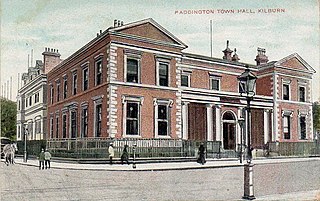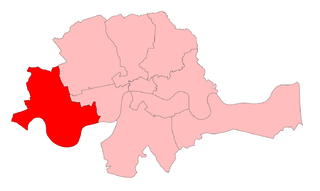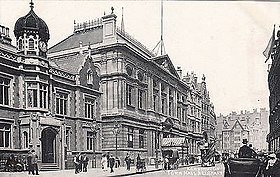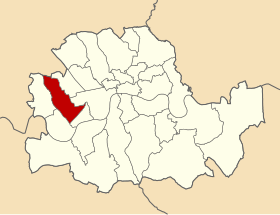
The Royal Borough of Kensington and Chelsea is an Inner London borough with royal status. It is the smallest borough in London and the second smallest district in England; it is one of the most densely populated administrative regions in the United Kingdom. It includes affluent areas such as Notting Hill, Kensington, South Kensington, Chelsea, and Knightsbridge.

Notting Hill is a district of West London, England, in the Royal Borough of Kensington and Chelsea. Notting Hill is known for being a cosmopolitan and multicultural neighbourhood, hosting the annual Notting Hill Carnival and the Portobello Road Market. From around 1870, Notting Hill had an association with artists.

Camberwell was a civil parish and metropolitan borough in south London, England. Camberwell was an ancient parish in the county of Surrey, governed by an administrative vestry from 1674. The parish was included in the area of responsibility of the Metropolitan Board of Works in 1855 and became part of the County of London in 1889. The parish of Camberwell became a metropolitan borough in 1900, following the London Government Act 1899, with the parish vestry replaced by a borough council. In 1965 the borough was abolished and its former area became part of the London Borough of Southwark in Greater London.

Paddington was a civil parish and metropolitan borough in London, England. It was an ancient parish in the county of Middlesex, governed by an administrative vestry. The parish was included in the area of responsibility of the Metropolitan Board of Works in 1855 and became part of the County of London in 1889. The parish of Paddington became a metropolitan borough in 1900, following the London Government Act 1899, with the parish vestry replaced by a borough council. In 1965 the borough was abolished and its former area became part of the City of Westminster in Greater London.

Hampstead was a civil parish and metropolitan borough in London, England. It was an ancient parish in the county of Middlesex, governed by an administrative vestry. The parish was included in the area of responsibility of the Metropolitan Board of Works in 1855 and became part of the County of London in 1889. The parish of Hampstead became a metropolitan borough in 1900, following the London Government Act 1899, with the parish vestry replaced by a borough council. In 1965 the borough was abolished and its former area became part of the London Borough of Camden in Greater London.

Islington was a civil parish and metropolitan borough in London, England. It was an ancient parish within the county of Middlesex, and formed part of The Metropolis from 1855. The parish was transferred to the County of London in 1889 and became a metropolitan borough in 1900. It was amalgamated with the Metropolitan Borough of Finsbury to form the London Borough of Islington in Greater London in 1965.

The Metropolitan Borough of Chelsea was a metropolitan borough of the County of London between 1900 and 1965. It was created by the London Government Act 1899 from most of the ancient parish of Chelsea. Following the London Government Act 1963, it was amalgamated with the Royal Borough of Kensington in 1965 to form the Royal Borough of Kensington and Chelsea.

Hammersmith was a civil parish and metropolitan borough in London, England. It was formed as a civil parish in 1834 from the chapelry of Hammersmith that had existed in the ancient parish of Fulham, Middlesex since 1631. The parish was grouped with Fulham as the Fulham District from 1855 until 1886, when separate parish administration was restored. In 1889 it became part of the County of London and in 1900 it became a metropolitan borough. It included Hammersmith, Wormwood Scrubs, Old Oak Common and Shepherd's Bush. In 1965 it was abolished and became the northern part of the London Borough of Hammersmith, since 1979 renamed the London Borough of Hammersmith and Fulham.

Poplar was a local government district in the metropolitan area of London, England. It was formed as a district of the Metropolis in 1855 and became a metropolitan borough in the County of London in 1900. It comprised Poplar, Millwall, Bromley-by-Bow and Bow as well as Old Ford, Fish Island and Cubitt Town.

Kensington and Chelsea was a constituency represented in the House of Commons of the Parliament of the United Kingdom 1997–2010. It was one of the safest Conservative seats in the United Kingdom, and since its creation in 1997 became a prestigious seat, with MP Alan Clark, the former Defence Secretary Michael Portillo and the former Foreign Secretary Malcolm Rifkind all holding the seat for the Conservatives. The seat was abolished for the 2010 election, when the 1974–1997 Kensington constituency was recreated and Chelsea formed a new constituency together with the southern part of the former Hammersmith and Fulham constituency, called the Chelsea and Fulham constituency.

Regent's Park and Kensington North was a constituency in Central and West London represented in the House of Commons of the UK Parliament. It elected one Member of Parliament (MP) by the first past the post system of election from 1997 to 2010.

Kensington is a former constituency in Greater London which first existed between 1974 and 1997 and was recreated in 2010. Since 2019, it has been represented in the House of Commons of the UK Parliament by Felicity Buchan of the Conservative Party. On 29 November 2023, it was replaced by the Kensington and Bayswater constituency, and will be first contested at the next general election.

North Kensington is an area of west London. It is north of Notting Hill and south of Kensal Green and in the Royal Borough of Kensington and Chelsea. The names North Kensington and Ladbroke Grove describe the same area.

Chelsea was a borough constituency, represented in the House of Commons of the Parliament of the United Kingdom.
Kensington North was a parliamentary constituency centred on the Kensington district of west London. It returned one Member of Parliament (MP) to the House of Commons of the Parliament of the United Kingdom.

Kensington South was a parliamentary constituency centred on the Kensington district of west London. It returned one Member of Parliament (MP) to the House of Commons of the Parliament of the United Kingdom.

Kensal Town is a sub-district of North Kensington located at the very north of the Royal Borough of Kensington and Chelsea where the Grand Union Canal forms the boundary with the City of Westminster. The area lies four miles north-west of Charing Cross and is part of the W postcode area. Kensal Town was an exclave of Chelsea from the middle ages, through to 1900.

Golborne Road is a street in the Royal Borough of Kensington and Chelsea in London's Kensal Town. The road runs east from Portobello Road to Kensal Road.

The 2022 Kensington and Chelsea London Borough Council election was held on 5 May 2022. All 50 members of Kensington and Chelsea London Borough Council were elected. The elections took place alongside local elections in the other London boroughs and elections to local authorities across the United Kingdom.

Kensington and Bayswater is a new constituency of the House of Commons in the UK Parliament. Proposed in 2023 Periodic Review of Westminster constituencies, which was made into law on 29 November 2023, it will first be contested at the next general election.



 Map of borough boundary
Map of borough boundary



















